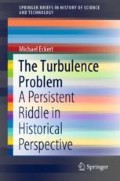Abstract
In the mid-1930s the turbulence problem became the subject of a statistical theory developed by Geoffrey Ingram Taylor. It was to a large extent motivated by the concern about wind tunnel turbulence. From an experimental perspective the breakthrough came with the hot-wire technique that enabled precise measurements of grid-turbulence in wind tunnels. Theodore von Kármán and Leslie Howarth extended Taylor’s theory. In 1938, statistical theories of turbulence took centre-stage at a symposium on turbulence as part of the Fifth International Congress for Applied Mechanics. Apart from the mainstream statistical theories, Johannes Martinus Burgers developed simplified mathematical models in an attempt to capture the principal features of turbulence—with an alternative view on statistical theories.
Access this chapter
Tax calculation will be finalised at checkout
Purchases are for personal use only
Notes
- 1.
Noether (1931) . Translation ME.
- 2.
Dryden to Prandtl, 5 March 1921. MPGA, Abt. III, Rep. 61, Nr. 361. For more detail see Eckert (2006, Sect. 5.5).
- 3.
Dryden to Prandtl, 8 May 1931. MPGA, Abt. III, Rep. 61, No. 361.
- 4.
Prandtl to Taylor, 23 December 1932. MPGA, Abt. III, Rep. 61, Nr. 1653. Translation ME.
- 5.
An appraisal of Taylor’s theory is beyond the scope of this brief history. For a short review and hindsight evaluation see Sreenivasan (2011, Sect. 4.5) .
- 6.
Taylor to Prandtl, 2 March 1935. MPGA, Abt. III, Rep. 61, Nr. 1654.
- 7.
The dispute is reflected in the correspondence between Kármán and Taylor by “sometimes testy exchanges”, but otherwise did not affect their friendly relationship. See Leonard and Peters (2011, pp. 115–119) and Sreenivasan (2011, pp. 159–161) .
- 8.
Prandtl to Ludwig Hopf, 15 October 1938. AMPG, Abt. III, Rep. 61, Nr. 2153. Translation ME.
- 9.
Sommerfeld to Prandtl, 31 January 1945. MPGA, Abt. III, Rep. 61, Nr. 1538.
- 10.
Sommerfeld (1945, pp. 261) . Translation ME.
- 11.
Sommerfeld (1945, pp. 269–272) . Translation ME.
Author information
Authors and Affiliations
Corresponding author
Rights and permissions
Copyright information
© 2019 The Author(s), under exclusive license to Springer Nature Switzerland AG
About this chapter
Cite this chapter
Eckert, M. (2019). The Rise of Statistical Theories of Turbulence. In: The Turbulence Problem. SpringerBriefs in History of Science and Technology. Springer, Cham. https://doi.org/10.1007/978-3-030-31863-5_3
Download citation
DOI: https://doi.org/10.1007/978-3-030-31863-5_3
Published:
Publisher Name: Springer, Cham
Print ISBN: 978-3-030-31862-8
Online ISBN: 978-3-030-31863-5
eBook Packages: Physics and AstronomyPhysics and Astronomy (R0)

